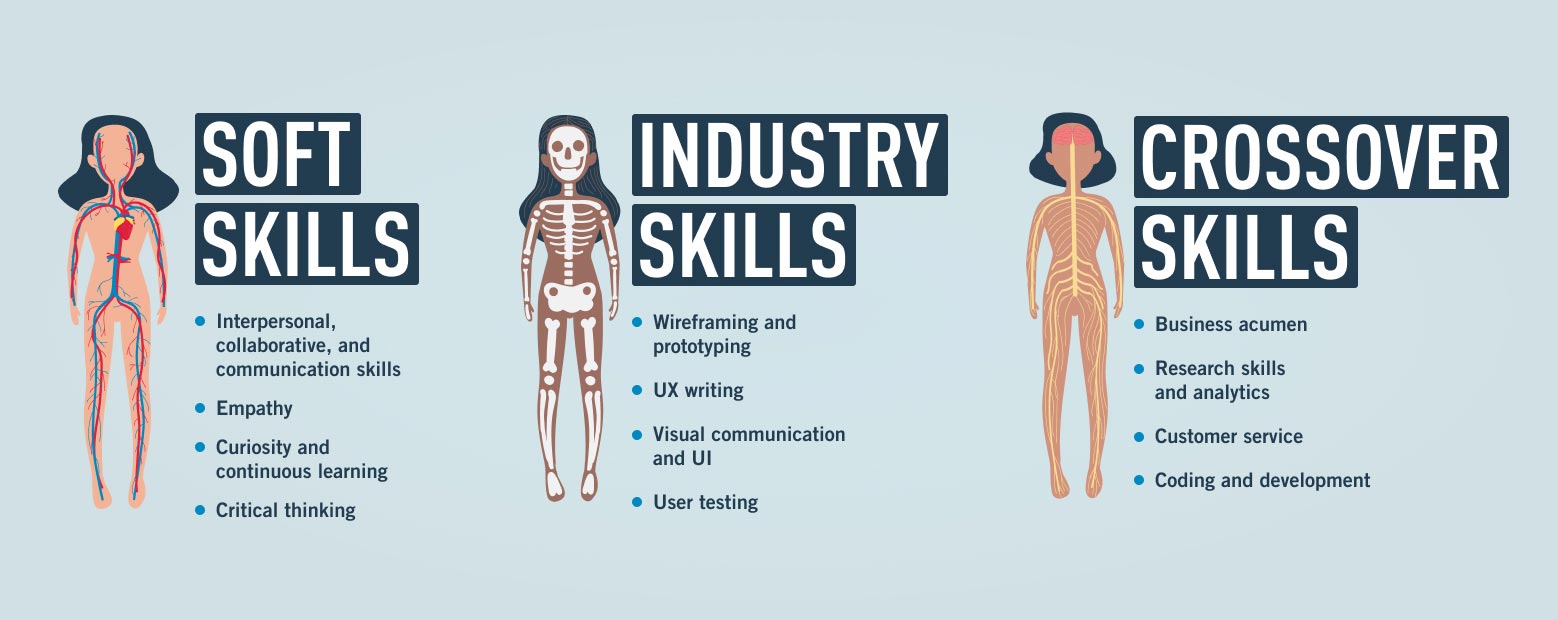It’s a common question among aspiring UX designers: Do I need a degree to become a successful UX designer.
And the short answer is: No. Some related experience and training is necessary, of course, but employers are far more interested in what you can do than how you learned to do it.
While a design or tech-related degree can certainly help to prepare you for a job in UX, it’s not a guaranteed key to success.
So if employers don’t just look at your educational background to assess your capabilities, what do they care about? Let’s find out. This guide will walk you through what you really need to break into the field, and what kind of training and experience will best prepare you for the job.
Here’s what we’ll cover:
- Is a degree necessary to land a job in UX?
- What do you really need to kickstart a career in UX design?
- The best UX training: A checklist
- Final thoughts
A brief note before we begin: If you’re looking for an accredited training to help with official paperwork (such as obtaining or retaining a residence visa in a foreign country), chances are you will need a university degree and/or a certain number of years of experience. Please research to learn more about the requirements that apply to your particular situation.
Now…let’s get to it!

Is a degree necessary to land a job in UX?
Not so very long ago, this would have been a ridiculous question, because of course you’d need a degree for your career to get off the ground and to ensure its success. Having a university degree was the most widely-accepted, credible, and even prestigious way of proving that you had training and experience in a given field.
These days, however, that’s simply not the case. Though employers will certainly take your educational background into account, it’s usually not the primary determining factor. Here are three reasons why:
1. Because the tech industry changes and evolves rapidly
While a degree might carry with it an element of prestige and “proven” knowledge, accredited institutions (and their curriculum) are not always on the cutting edge, which means your degree may or may not reflect a knowledge base and skillset that matches the current demands in the industry.
Degrees also vary greatly in quality and scope, which means that without getting a pretty detailed look at what courses you took, the tools you learned, the projects you completed—and the grades you earned—a degree can only give employers a general sense of what you might know.
2. Because UX design is an extremely practical, hands-on field
Successful UX designers have a broad range of skills and competencies—and the vast majority of those skills and competencies are wildly practical in nature.
Employers know that a degree can make an applicant look great on paper who is, perhaps, not as great on the job. What they’re looking for is a clear demonstration of practical skills. You can showcase these without a university degree in your resume. Here’s how:
- Give employers a glimpse of your actual work through a set of high-quality case studies in your UX portfolio (usually before you even land an interview)
- Complete a design challenge as part of the interview process
- Provide references who can attest to your excellent UX design skills, as well as those non-design related skills (such as empathy and communication) that are absolutely essential to being an active member of a team
3. Because an “unrelated” background is often desirable in a candidate
More and more employers value employees with (seemingly) unrelated backgrounds. With or without a degree, if you bring outside experience into a new role as a UX designer, you’re bringing a wealth of fresh insights and a perspective that can help you reimagine problems and find truly innovative solutions.
You will of course need enough experience that you can showcase your skills in the ways we’ve already outlined. Add to that an ability to identify and communicate your transferable skills, and you’re well on your way.
On that note, let’s look at what you really do need to break into UX design, followed by what kind of training will best prepare you for that first role.
What do you really need to kickstart a career in UX design?
Bottom line, what you need most is:
- The core UX design skillset, and
- The ability to demonstrate your UX design skills and core competencies in clear and dynamic ways
Let’s break these two essentials into bite-sized bits.
Core UX design skills

There’s a wide range of soft skills and industry skills that are essential—as well as some crossover skills that are either required (depending on the company and the role) or that will make you really stand out in a sea of applicants. Here’s a summary of the skills you’ll need to make it as a UX designer:
Soft skills
- Collaboration (and feedback)
- Communication
- Empathy
- Critical thinking
- Curiosity
- Growth mindset (continuous learning)
Industry skills
- User research and testing
- Key UX deliverables (personas, customer journey maps, etc.)
- Wireframing
- Prototyping
- UX writing
- Visual communication and UI design
Crossover skills
- Business acumen
- Research and analytics
- Customer service
- Coding and development
If you’d like to learn more about these skills and competencies, our UX design skills guide is a great place to start.
How to demonstrate your UX design skills
With or without a degree to prove your UX design chops, how do you show employers that you’ve got what it takes? This will all come down to:
- The quality of your cover letter and resume (a great opportunity to sell your transferable skills)
- Your job-winning UX portfolio
- The soft skills you demonstrate throughout the interview process
Let’s have a brief look at each of these.
An outstanding UX cover letter and resume
Here it is. The golden rule to writing an excellent UX cover letter and resume:
Every cover letter and resume you send out should be specifically tailored to the company that’s hiring for the role you’re hoping to land.
These two little documents are an excellent opportunity to communicate your transferable skills in ways that allow employers to see the very real value your previous experience would bring to their company.
We’ve got even more tips for this in our full UX cover letter guide.
Whether you’re a graphic designer looking for a change, a teacher hoping to break into UX design, or just about any other background—chances are that you have loads of transferable skills that can boost your confidence going into a new career. Be sure to identify those skills and highlight them!
A job-winning UX portfolio
Your portfolio is your best chance to really showcase not only what you do (the results of your work), but who you are as a designer.
It will also show off the texture of your design process—how you approach problems, what kinds of questions you ask, the tools you use, and how you reflect on your process to extract learning and improve next time around.
And the best way to craft a UX portfolio that accomplishes all of this? Write amazing case studies.
A case study succinctly tells the story of one particular project, from start to finish—and highlights key deliverables along the way.
Want to learn more about how to write a great case study? Check out our guide: How to craft an outstanding case study for your UX portfolio.
Making the most of the interview process
From an initial phone screen, to a design challenge, to however many rounds of interviews the company holds to find the right candidate for the job—every step of the way is your chance to show the hiring manager and your potential teammates:
- How organized and prepared you can be
- What your authentic communication style is like
- How you approach problems
- What kinds of questions you ask
To learn more about how to prepare for a UX interview, check out our guide for the top 11 UX interview questions you should be ready for.
From your cover letter and resume, to your portfolio and interview—approach these mindfully and bring just a little extra care to how you craft these key ingredients in your application packet. This will help you stand out from other applicants and give employers a clearer picture of who you are and what you do.

The best UX training: A checklist
The one most important kind of training? You need hands-on, mentored experience that allows you to learn as you apply ideas and concepts to real-world projects for your portfolio.
As we’ve already said, UX design is an incredibly practical and hands-on field. For most people who are coming to UX from a different background—whether you’re a graphic designer, teacher, barista, or anything else—the learning curve is usually in the technical, industry-related skills.
Soft skills and interpersonal competencies, and even some of the crossover skills we outlined earlier in this guide, are developed over time in any number or variety of roles.
The UX-specific skills are the ones you’ll likely need to focus on if you want to build a well-rounded and impactful application packet (that winning cover letter, resume, portfolio, interview prep combination).
There are certainly degree programs out there that will give you the chance to develop these practical skills, but accredited degree programs also:
- Cost more than other training options
- Take longer to complete, usually with a higher time investment overall
- Aren’t always current with industry demands
- Are simply not the only kind of training or credential that employers will accept
Bootcamps and certification programs, on the other hand, are:
- Usually more affordable than a degree
- Easier to complete over a shorter period of time while keeping up with other obligations
- More often synched up with the needs of the industry
- Widely accepted by hiring managers as an indicator that you’ve learned the practical skills and you’ve put them in action
- Usually more in synch with UX industry trends and best practices
All that said, there are certainly pros and cons to each. If you’d like to better understand these, check out our guide to the advantages and disadvantages of a design degree versus a UX bootcamp. And don’t underestimate the power of doing your own UX design-related reading to learn and explore.
Whether you’re looking at degree programs, UX bootcamps, certifications, or a good old D-I-Y education in UX, here’s our checklist for ensuring the best training path on the way to that dream job. Whatever training path you choose, make sure it includes:
- Learning materials to help you understand and implement design thinking and the UX design process
- Examples of the best design thinking at work in the world—what it looks like and how it’s done
- Hands-on practice at a variety of design thinking exercises
- Hands-on experience in taking projects through the UX design process, from start to finish—conducting user research, crafting personas, developing wireframes, and more
- Conversations with other UX designers—whether seasoned, new, or aspiring. Learning happens in community!
- A mentor with tons of experience in the field who is happy to provide loads of feedback on your work, help you fine-tune your portfolio, give insight into the industry, and offer advice to help shape your career
- Some kind of job preparation—individualized advice for how to craft your application packet to attract the kinds of employers and teams you want to work for
Final thoughts
Do you need a degree to make it in UX design? No. Long gone are the days when a university degree was the only acceptable way to prove your mettle. If a degree program happens to suit your needs and goals best—go for it! But know that there are options.
What’s more important is the skills you master and can demonstrate in dynamic and practical ways. So whatever path you choose, be sure to:
- Spend some time immersing yourself in design thinking
- Work on some personal or volunteer projects that really interest you, taking a digital product through the UX design process from start to finish
- Find a seasoned UX design mentor who can guide and challenge you to become the best designer you can be
- And get some job search advice that is specific to your background, your location, and where you want your career to go
If you’d like to learn more about kickstarting a career in UX design, here are some articles that you’ll find helpful:
